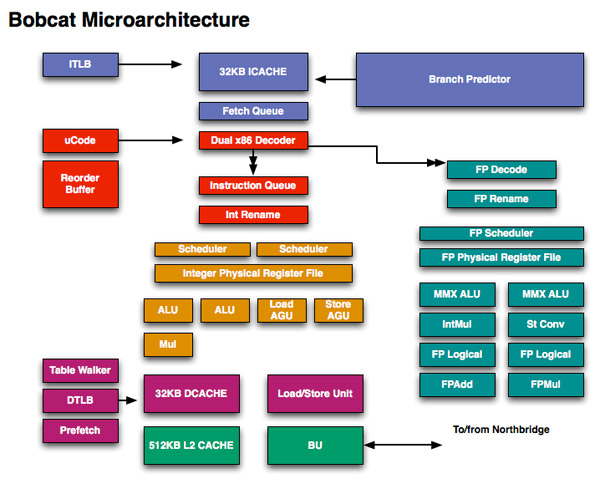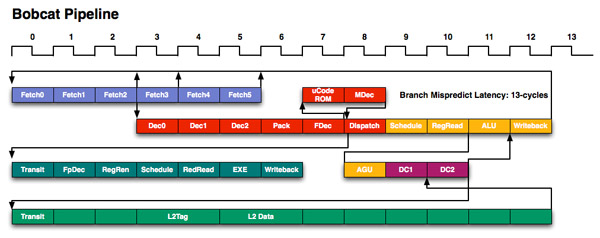AMD Discloses Bobcat & Bulldozer Architectures at Hot Chips 2010
by Anand Lal Shimpi on August 24, 2010 1:33 AM ESTIt’s an Out of Order Atom
Ever since the Pentium Pro (P6), we have been blessed with out of order microprocessor architectures - these being designs that can execute instructions out of program order to improve performance. Out of order architectures let you schedule independent instructions ahead of others that are either waiting for data from main memory or waiting for specific execution resources to free up. The resulting performance boost comes at the expense of power and die size. All of the tracking logic to make sure that instructions executed out of order still retire in order eats up die area as well as more power.
When Intel designed the Atom processor it went back to an in-order design as a way of reducing power. Intel has committed to using in-order architectures in Atom for 4 - 5 years post introduction (that would end sometime in the 2012 - 2013 time frame).
For smartphones, Intel’s commitment to in-order makes sense. Average power consumption under load needs to remain at less than 1W and you simply can’t hit that with an out-of-order Atom at 45nm.
For netbooks and notebooks however, the tradeoff makes less sense. Jarred has often argued that a CULV notebook is a far better performer than a netbook at very similar price/battery life metrics. No one is pleased with Atom’s performance in a netbook, but there’s clearly demand for the form factor and price point. Where there’s an architectural opportunity like this, AMD is usually there to act.
Over the past decade AMD has refrained from copying an Intel design, instead AMD usually looks to leapfrog Intel by implementing forward looking technologies earlier than its competitor. We saw this with the 64-bit K8 and the cache hierarchy of the original Phenom and Phenom II processors. Both featured design decisions that Intel would later adopt, they were simply ahead of their time.
With Atom stuck in an in-order world for the near future, AMD’s opportunity to innovate is clear.
The Architecture
Admittedly I was caught off guard by Bobcat’s architecture: it’s a dual-issue design, the first AMD has introduced since the K6 and also the same issue width Intel chose for Atom. Where AMD and Intel diverge however is in the execution side: Bobcat is a fully out of order architecture.
The move to out of order should provide a healthy single threaded performance boost over Atom, assuming AMD can ramp clocks up. Bobcat has a 15 stage integer pipeline, very close to Atom's 16 stage pipe. The two pipeline diagrams are below:

Intel's Atom pipeline
You’ll note that there are technically six fetch stages, although only the first three are included in the 15 stage number I mentioned above. AMD mentioned that the remaining three stages are used for branch prediction, but in a manner it is unwilling to disclose at this time due to competitive concerns.
Bobcat has two independent, dual ported integer scheduler. One feeds two ALUs (one of which can perform integer multiplies) while the other feeds two AGUs (one for loads and one for stores).
The FPU has a single dual ported scheduler that feeds two independent FPUs. Similar to the Atom processor, only one of the ports can handle floating point multiplies. The FP mul and add units can perform two single precision (32-bit) multiplies/adds per cycle. Like the integer side, the FPU uses a physical register file to reduce power.
Bobcat supports SSE1-3, with future versions adding more instructions as necessary.

Bobcat supports out of order loads and stores similar to Intel’s Core architecture as well.
The Bobcat core has a 3-cycle 64KB L1 (32KB instruction + 32KB data cache) that’s 8-way set associative. The L2 cache is a 17-cycle, 512KB 16-way set associative cache. I originally measured Atom’s L1 and L2 at 3 and 18 cycles respectively (I’ve heard numbers as low as 15 for Atom’s L2) so AMD is definitely in the right ballpark here.

Intel's Atom Microarchitecture
Unlike the original Atom, Bobcat will never ship as a standalone microprocessor. Instead it will be integrated with other cores and a GPU and sold as a single SoC. The first incarnation of Bobcat will be a processor due out in early 2011 for netbooks and thin and light notebooks called Ontario. Ontario will integrate two Bobcat cores with an AMD GPU manufactured on TSMC’s 40nm process (Bobcat will be the first x86 core made at TSMC). This will be the first Fusion product to hit the market.

Note that there's an on-die memory controller but it's actually housed in between the CPU and GPU in order to equally serve both masters.











76 Comments
View All Comments
Mr Perfect - Wednesday, August 25, 2010 - link
It sounds like AMD will be selling by the integer core though, not by module. There's this from Page 4:"Processors may implement anywhere from one to four Bulldozer modules and will be referred to as 2 to 8 core CPUs."
So they will be referring to four module APUs as having eight cores, rather then a quad core with HyperThreading.
silverblue - Wednesday, August 25, 2010 - link
Sorry, I did mean to tackle the part of your thread dealing with different versions of Bulldozer. Valencia is a server version of Zambezi, i.e. 4 modules/8 threads. Interlagos is 8 modules/16 threads.From AMD's own figures, each module is 1.8 times the speed of a current K10.5 core at the same clock speed. It is a little unfair to compare "core" to core due to the way they're designed and implemented. Considering each K10.5 core has three ALUs and Bulldozer has two per integer core, 90% of that integer performance is very good - for a quad core CPU in the current sense, Bulldozer would theoretically outpace Phenom II by 80% in integer work by only having 33% more integer resources, assuming the chip is well fed. If the rumours about a quad-channel memory bus are correct, you'd hope it would be.
jeremyshaw - Wednesday, August 25, 2010 - link
I believe Intel also delegated some Atom production to TSMC, unless if I am wrong?Penti - Thursday, August 26, 2010 - link
TSMC also does manufacture VIAs / Centaur Tech x86 processor.Probably a few others too. There's some x86 SoCs for embedded stuff from other vendors.
Perisphetic - Wednesday, August 25, 2010 - link
It's time to kick ass and chew bubble gum... and AMD is all outta gum.NaN42 - Wednesday, August 25, 2010 - link
At first: I think AMD made a huge progress with Bulldozer.But I'm wondering how the FPU will work exactly. A look at the latencies (especially of fma-instructions) would be interesting too. Another question is, if it is possible to start one independent multiply and one addition at the same time in a FMAC-unit. Furthermore the throughput is of interest. Is it one mul and add instruction per cycle? Is there any advantage to use 256 bit AVX-instructions, besides shorter code?
I appreciate that AMD will drop most 3Dnow-instructions because these are just outdated. Perhaps they could also drop MMX instructions but maintain x87-instructions because these are sometimes useful and needed.
I expect the decoder besides the FPU (compared to Sandy Bridge) to be another bottleneck because the 4-wide decoder has to feed two nearly independent cores and todays 3-wide decoders (except those in Nehalem/Westmere) are sometimes a bottleneck in a single core design.
@Ontario: I expect this platform to be much more powerful than the Atom platforms. Perhaps it will even be much more efficient than Atom. A direct comparison between Ontario and VIA Nano 3000 might be interesting especially when VIA releases dual core chips.
GourdFreeMan - Thursday, August 26, 2010 - link
It seems that AMD is ceding the traditional laptop and desktop market to Intel and chasing the server market and Atom/ARM's market with Bulldozer and Bobcat respectively. Lower theoretical peak IPC and greater parallelism target well the high level of data and transaction level parallelism in the server market, but existing consumer software excepting video encoding and a handful of games still tend to favor single threaded performance over parallelism. I suppose we should wait for benchmarks in actual applications to see how well architectural improvements have impacted the performance of AMD's new designs, but I imagine some people are already disappointed. Too bad the resources in both integer cores in a module can't work on a single thread, otherwise we could have had a very serious contender on the desktop...silverblue - Thursday, August 26, 2010 - link
He sure seemed confusing on the comments page of his blog a few weeks back. Understandably evasive considering he's a server tech guy, not consumer tech, plus AMD were yet to reveal these details, but he was comparing 16 Bulldozer cores to 12 Magny Cours cores, which is technically incorrect as they're not comparable UNLESS you're talking about integer cores. At least, that's my interpretation.AMD will probably market Zambezi as an 8-core CPU in order to woo the more-is-better crowd, but regardless of how it handles multi-threading, I still view a module as an actual core virtue of the fact that the "cores" are not independant of the module they belong to. I know I'm wrong and that's fine, but it helps in understanding the technology better - eight cores that exist in pairs and share additional resources might serve to confuse.
gruffi - Thursday, August 26, 2010 - link
A 12-core Magny-Cours has 12 "integer cores" and 12 128-bit FPUs. A 16-core Interlagos has 16 "integer cores" and 16 128-bit FMACs. Why is it technically not comparable? At least you know you are wrong. ;)silverblue - Friday, August 27, 2010 - link
The implementation is very different to what AMD have done before, that's what I'm trying to get at. Everyone knew that despite Intel and AMD having different types of quad core processor prior to Nehalem, they were still classed the same so I suppose it doesn't matter in the grand scheme of things. There's nothing to stop AMD from releasing a 24-"core" Bulldozer; it shouldn't be any larger than Magny-Cours - perhaps slightly smaller in the end - yet its integer performance would be through the roof.However, people are bemoaning the fact that for 33% more "cores", AMD are only getting 50% extra performance - it's worth bearing in mind that AMD does this with 4 less, albeit better utilised ALUs than Magny-Cours (32 compared to 36). Make no mistake, Bulldozer is far more efficient and capable in this scenario, but I can't help wondering how strong Phenom II may have been if it'd had a slightly more elegant design.